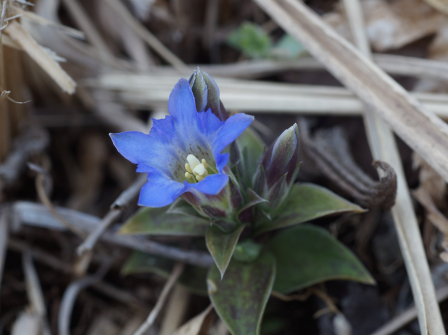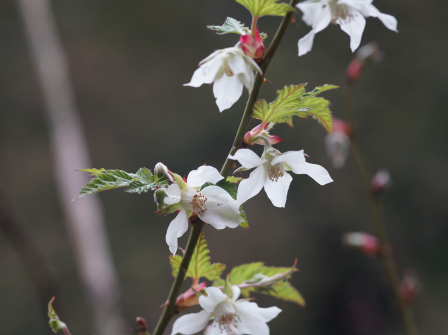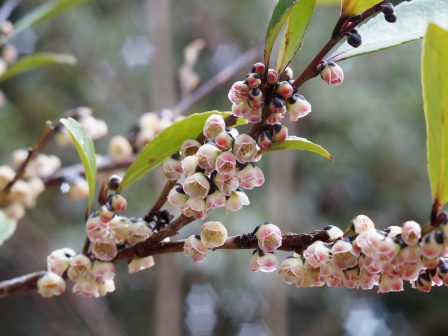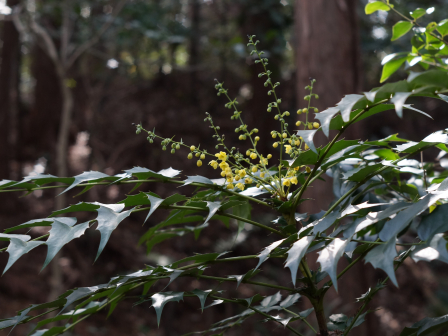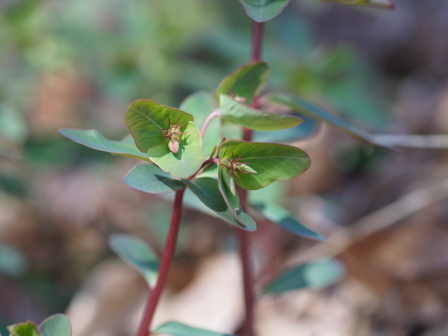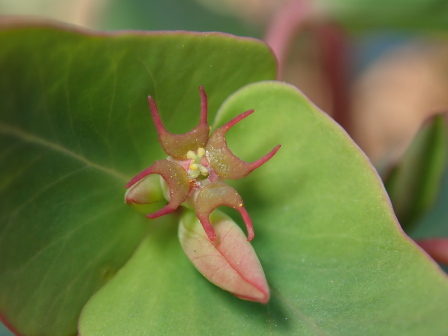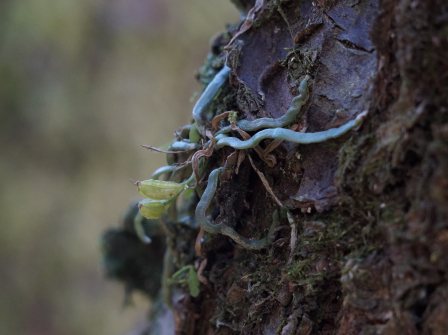フィールド日記
2023年03月
2023.03.31
タチツボスミレ
タチツボスミレが咲いています。最も普通に見られるスミレです。写真のような咲き始めの時期には目立ちませんが、地上茎があるタイプです。通常は茎に毛がなく、花は淡紫色ですが、毛の有無や色の濃淡には変異があります。
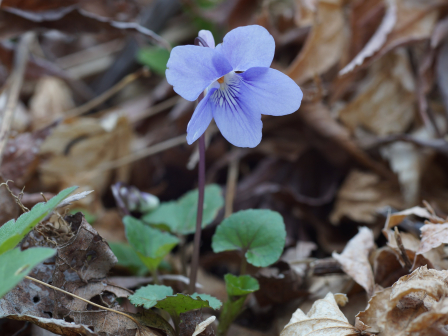
2023.03.28
フデリンドウ
フデリンドウが咲いています。明るい草地や雑木林に生える越年草です。不二聖心のススキ野原は、茶草場として利用されており、不二農園の方々によって毎年冬に草刈りが行われます。そのおかげで、フデリンドウの生育に適した明るい草地が維持されています。
"Fude-Rindou (フデリンドウ)" plants are in bloom. They are biennial plants that grow on sunny grasslands and wooded areas. The grassland on our campus is used as a "Chagusaba (茶草場)", so the farmers cut the grass every winter. Therefore, the grassland is kept as a sunny grassland that is a good place for "Fude-Rindou" plants.
2023.03.24
モミジイチゴ
モミジイチゴが咲いています。モミジの葉のように葉が切れ込み、花は下向きに咲きます。キャンパス内で見られるキイチゴのなかまの中では最も早く咲きます。果実は黄色に熟し、食用になります。
"Momiji-Ichigo (モミジイチゴ)" trees are in bloom. They have lobed leaves like "Momiji (Maple)" trees and they bloom downward. "Momiji-Ichigo" trees bloom earliest in the "Ki-Ichigo (キチイゴ)" group that we can see on campus. Their fruit ripen to yellow and are edible.
2023.03.21
ヒサカキ
ヒサカキが咲いています。強い独特な芳香があり、この時期にキャンパスを歩いていると花を見るよりも先に、匂いでヒサカキが咲き始めたことに気が付きます。雌雄異株で、写真は雄花です。通常は白い花を咲かせますが、写真のようにピンクがかった花を咲かせる個体もあります。
"Hisakaki (ヒサカキ)" trees are in bloom. They have a strong unique scent. Walking on the campus in this season, you can notice they are starting to bloom by their fragrence before seeing their flowers. They are dioecious, and the flowers in the photo are male flowers. They normally have white flowers, but some have pinkish flowers.
2023.03.17
キランソウ
築山の周りでキランソウが咲いています。道端などでよく見られる身近な野草です。地面をはうように広がるようすを蓋に見立てて、ジゴクノカマノフタ(地獄の釜の蓋)という別名を持っています。ちょっと恐ろしい名前ですが、薬草として利用され病気を治す(=地獄の釜の蓋が閉じる)という良い意味が由来のようです。
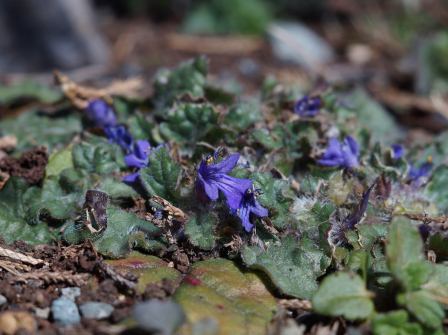
"Kiransou (キランソウ)" plants are in bloom around the artificial hill. They are a common wild flower that can be seen on road sides. They have an alias "Jigokuno-Kamano-Futa (ジゴクノカマノフタ)", as we see them spreading on the ground as a lid. The alias means "Lid of Hell's Cauldron" so it sounds a little scary. However, the alias also implies a the good meaning that they are used as medicinal herb and cure diseases ( = so the plants cover Lid of Hell's Cauldron.)
2023.03.14
ミチタネツケバナ
築山でミチタネツケバナが咲いています。ヨーロッパ原産の帰化植物です。在来種のタネツケバナに似ていますが、茎の途中にはあまり葉をつけないことや、果実が茎や花に寄り添ってつくことなどから見分けることができます。
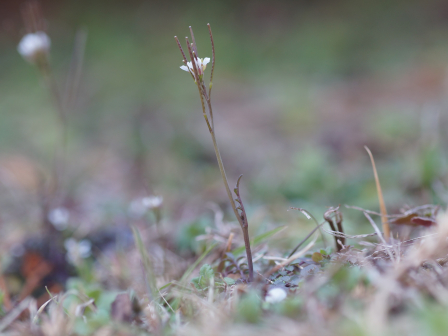
"Michi-Tanetsuke-Bana (ミチタネツケバナ)" plants are in bloom on the artificial hill. They originally come from Europe. They resemble a native species "Tanetsuke-Bana (タネツケバナ)." You can tell "Michi-Tanetsuke-Bana" from "Tanetsuke-Bana" because "Michi-Tanetsuke-Bana" has fewer leaves along its stems and its fruits surround its flowers.
2023.03.10
ヒイラギナンテン
林内でヒイラギナンテンが咲いています。学名をBerberis japonicaといい、「日本の」を意味する種小名をもっていますが、ヒマラヤから台湾、中国が原産で日本には17世紀に渡来したといわれています。庭や公園などによく植栽されますが、逸出したものが林内でも見られます。
"Hiiragi-Nanten (ヒイラギナンテン)" trees are in bloom in forests. Although their scientific name is "Mahonia japonica" and their species name "japonica" means "Japanese", they originally grew spreading from the Himalaya region to Taiwan and China and came to Japan in the 17th century. "Hiiragi-Nanten" trees are often planted in gardens and parks, but you can see the trees that have escaped into forests.
2023.03.07
ナツトウダイ
クヌギ林でナツトウダイが咲いています。名前にナツがつきますが、花は春に咲きます。
花には先のとがった三日月形の腺体が4個ついており、蜜を分泌しています。
The "Natsu-Toudai (ナツトウダイ)" plants are in bloom in the Japanese chestnut oak woodland. The name has "Natsu (ナツ)", which means "summer", but they bloom in spring. The flowers have four crescent-pointed glands, producing nectar.
2023.03.03
クモラン
梅の木に着生しているクモランが果実をつけています。クモランは葉をもっておらず、代わりに葉緑体をもった根が放射状に広がり、光合成をしています。このユニークな姿を蜘蛛に見立ててクモランと呼ばれています。花は初夏に咲きますが、果実は翌春に熟します。写真のクモランも、まもなく果実が開き、ほこりのような細かい種子を飛ばすと思われます。
The "Kumo-Ran (クモラン)" orchids growing on a plum tree are bearing their fruit. They have no leaves, so they photosynthesize with their roots having chloroplasts that spread out radially. The name comes from the fact that people view the shape of its roots as a spider. They bloom in early summer and bear fruit in the following spring. The fruit of the "Kumo-Ran" in the photo will probably ripen and spread its seeds soon.
- 1 / 1


